
In the West of Germany, one could doubt quality could return in these vineyards in the North-Easternmost region of the country: Saale-Unstrut and Saxony. Too recent viticultural tradition? The Saale-Unstrut vineyard is thousand years old and the one of Saxony will celebrate its 850 during the great 2011 jubilee. Poor terroir? Even if the harsh climate occasionaly destructs 20 to 90% of the harvest (1997, 2009), most of the time hot and sunny summers balance the rigor of the winter. The vine feels well on the frequently terraced steep hills facing South, with chalky or sandstone soils in the Unstrut and Saale valleys, or granit in the Elbe area.
The obstacle was during 40 years the ex-GDR, that of course, used to produce wine... Yes... But “in this socialist system, all men had to look alike, the wines also!” Thomas Herrlich, wine grower in Meissen (Saxony), regrets. The state co-ops imposed the varietals, the style of the wine that was often marked by woodiness. “No terroirs!” Thomas goes on. Each of the 5 to 6,000 wine growers of that period, “from Pirna to Diesbar Seuβlitz, close to Dresde, over some 40km, brought their grapes to the state-owned cooperative that made one and only wine per varietal! They had very few technique and experience.” Peter Bohn, Marketing Manager of the Domain Schloss Proschwitz (Saxony), summarizes. The wines were sold to top gastronomy or to international hotels. “We also consumed wine... but illegaly!” Thomas Herrlich laughs.
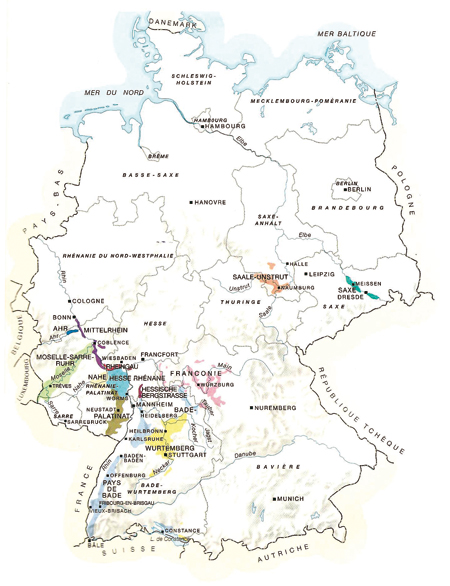
The dictatorship did not break Thomas' passion. Since the great-grandfather Vincenz Richter, each wine grower until him was called his name. Thomas studies beverage chemistry in Dresde and goes on “nach der Wende” (after the watershed) as we say more generally here to evoke the fall of the Wall. He calls his domain Vincenz Richter and relaunches the family restaurant (since 1873) of the same name. “I started with 500 litres. It was exhilarating, there were no laws. The wine was sold without marketing. Now we produce 120,000 litres on 9 hectares... but the administration is heavy!”
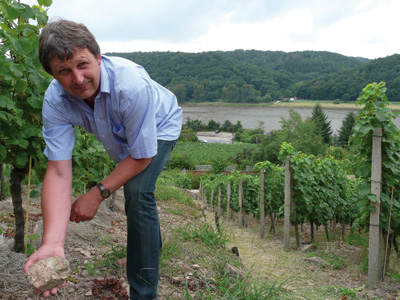
Thomas Herrlich et son terroir en terrasses à granite/syénite de Kapitelberg,
exposé plein sud et dominant l’Elbe.
Not so far away in the small village of Zadel, another fairy tale takes place: the Prince Georg zur Lippe, whose family had been deported to the West, bought back the family domain after the fall of the Wall, then the château in 1997: €10 million invested during the last ten years... and hard work! The château hosts events and also works as a guest house. An old ruined farm of Zadel has been restored to first shelter the cellar, then the offices, a guest house and finally a gastronomic restaurant. The firm -all activities included- now employs 65 persons.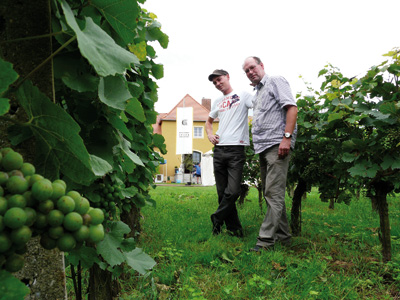
Andre Gussek et son fils Thomas. Du temps de la RDA, en Sachsen-Anhalt, la densité était de 3.000 pieds à l’hectare, 4.000 aujourd’hui, ce qui, avec la météo, explique les rendements plus faibles : « 50 - 60 hl/ha (ndlr : jusqu’à 90), alors qu’on est plutôt à 100 en Allemagne »
In Naumburg that is famous for its cathedral, Andre Gussek, after his beverage technology engineer diploma in East-Berlin, becomes in the 80s the cellar master of the Volkseigenesgut Weinberg (Vineyard of the People's Property). In 1986, he is allowed to cultivate 360 vine stocks. This is the start of his business “nach der Wende” and he works hard until 2001: the morning for himself, the afternoon and evening for the cooperative. Willing to learn, he stays for a time in Burgundy. Today the domain has 8 hectares of differentiated terroirs: Dachsberg (shell-limestone and clay) and its 80-year-old Sylvaner vines, then Sonneck, Steinmeister and Göttersitz.
Today the Saale-Unstrut vineyard covers 705 hectares. In the Sachsen-Anhalt area, 185 hectares are exploited by independant wine growers -half of them having an additional activity-, 46 hectares by the Landesweingut Kloster Pforta (State), 242 hectares by farms which also have orchards, and 142 hectares by wine producers. 80% of the wines produced with 30 varietals are dry; but you will also find semi-dry, mellow and sweet wines. The whites cover 73% of the surface areas. Among them, the Müller-Thurgau (25%) is the king, german varietal par excellence that gives aromatic and nervy wines thanks to controlled yields. Then comes the Weiβburgunder (Pinot blanc) (17%) which ampleness -longer and frequent maturation in barrels- surprizes somebody used to Alsacian Pinots blancs, the Sylvaner (11%) or the Riesling (10%). 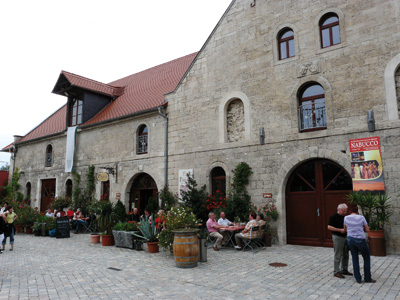
Comme souvent en Allemagne, les vignerons tiennent aussi un restaurant.
Celui des Pawis à Zscheiplitz (Saale-Unstrut), est une ancienne ferme domaniale restaurée.
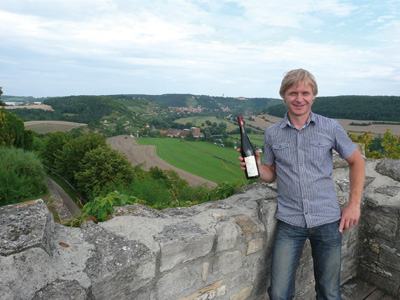
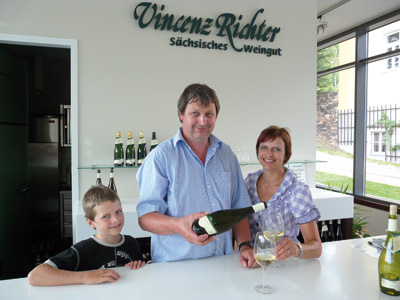
Thomas and Heike Herrlich, and their son Anton, with the traditional Saxon wine bottle:
“I do not drink woody wines. Riesling has to be served chilled.”
When tasted, the red wines often lack in substance whence, maturing in barrels that is often too marked. “With 1,700 hours of sun per year, an average temperature of 9,3°C and yields of 60 hl/ha, we do not get enough alcohol, structure nor fruit.” Jörg Fiedler, Sales Assistant at Schloss Proschwitz, admits. Thomas Herrlich left only 8% of his surface area in Spätburgunder: “20 hl/ha is the ideal yield to make good red wines”, and this is not viable of course. Thus it is better to choose the red wine in the good vintages: 2003, 2005 for Sachsen-Anhalt, 2003 and 2006 for Saxony. For the whites, the best domains -if they do not bring to much woodiness in their wines and control the provision of yeast (natural yeasts are barely exclusively used)- now rival the wines of Western Germany or Alsace.
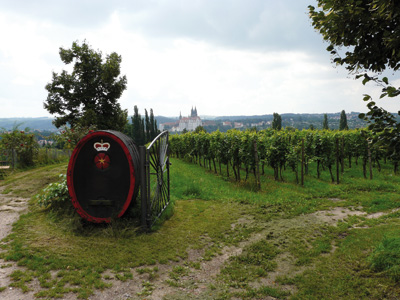
Les vignes du Schloss Proschwitz et la cathédrale de Meissen sur la route des vins de l’Elbe, inaugurée en 1992.
The best wines are sold locally and more and more in all Germany: private customers, restaurants, cellars, very few in superstores or hypermarkets. For the Schloss Proschwitz, all the wine merchants (40% of the sales) have been to the domain. Your turn to taste: Prosit!
Frédéric Ville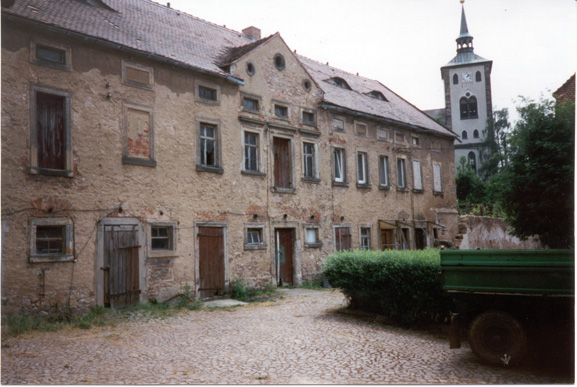

Weingut Vincenz Richter Meiβner Kapitelberg :